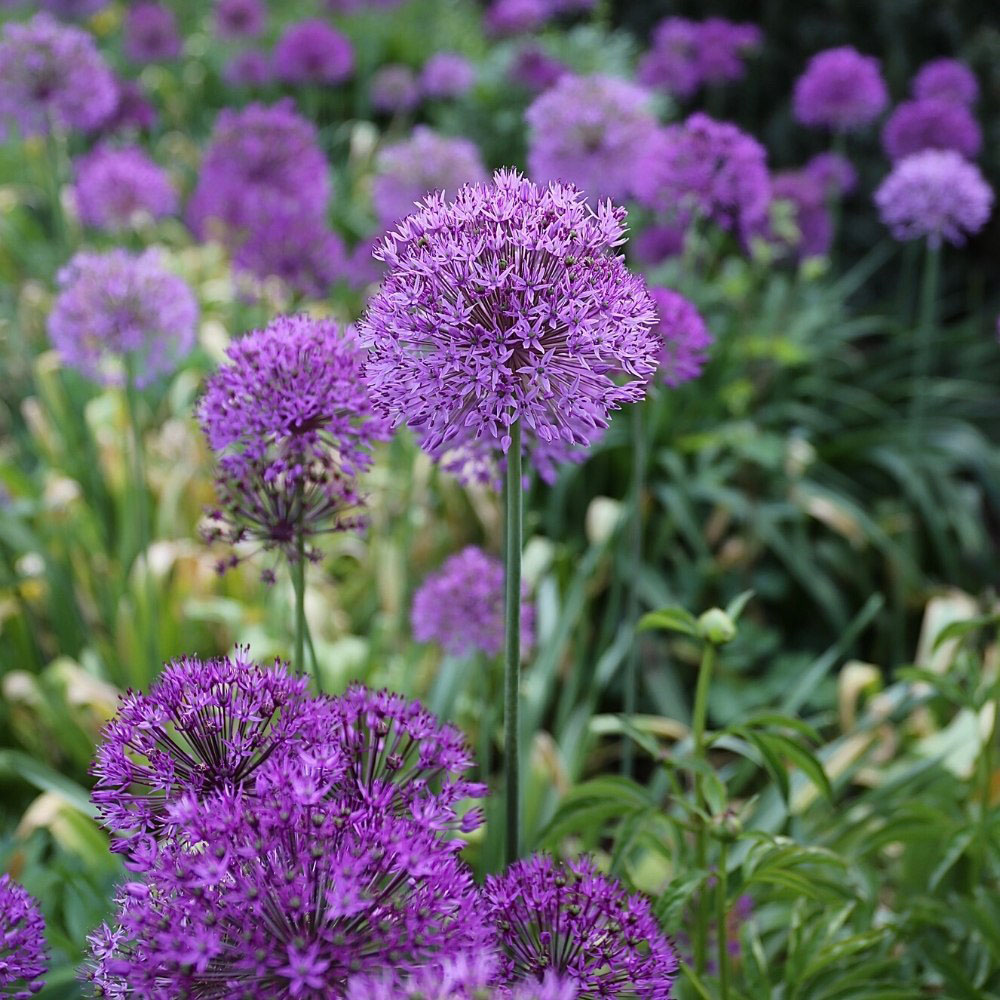
Gardening
Plant Alliums This Fall to Add Variety and Beauty to Your Garden

Purple Sensation allium livens up the early season garden with its violet-purple, four-inch diameter flowers.
Photo courtesy of Longfield-Gardens.com
Take your garden to new heights with alliums. This ornamental member of the onion family provides welcome color as spring bulbs fade and before summer perennials fill our gardens with colorful blooms.
Most people have seen pictures of the giant allium but there are many other options of flower sizes and heights suitable for any size and style garden. Most allium flowers are globe shaped and all are made of tiny florets. They make great cut flowers, the pollinators love them, and deer tend to leave them be.
Plan for months of color by including a variety of alliums that bloom from late spring through early summer. Longfield Gardens' Planning Guide for Alliums (Longfield-gardens.com) showcases the various alliums, their size and bloom time to help you plan. Add alliums to the zone four to eight garden in fall when planting your other spring flowering bulbs like tulips and daffodils.
Dress up the front of a flowerbed or rock garden with Allium karataviense. It may be small in stature at only eight to ten inches tall, but the broad grey-green leaves and five-inch round, silvery-pink flowers provide big impact in the late spring garden.
Add years of spring beauty with Purple Sensation. Its shimmering four-inch diameter, violet-purple flowers are held above the leaves on 24 to 30" tall stems. It provides nice height and vibrant color to the early season garden. You will enjoy these alliums and their offspring for years to come.
For something uniquely different add Allium bulgaricum, also known as Nectaroscordum bulgaricum, to perennial and informal gardens. The cluster of drooping cream and burgundy bell-shaped flowers are followed by seedpods that lift themselves skyward. This provides an interesting vertical accent in the garden.
Gladiator and Globemaster are sure to have passersby and visitors stopping to take a second look at your garden. Mix them in amongst perennials and add to mixed borders. Gladiator has blue-violet, six-inch diameter flowers that are smaller than Globemaster but Gladiator blooms earlier and stands a foot taller and the leaves are long lasting. Both are sure to grab your attention and that of pollinators.
Stretch your enjoyment into early summer with Ambassador. Its dense five- to six-inch, violet-blue flowers are a deeper color than most alliums. What's even more impressive is these large flowers are atop four- to five-foot stems. Like the other alliums, bees and butterflies love it.
It's no surprise that Allium christophii is a favorite among gardeners. The eight- to ten-inch diameter, violet-pink flowers have spikey florets and a silvery sheen that makes them look like globes in the garden. Though this allium is only 12-18" tall, it has a big presence in the garden and is very long-lasting.
Allium schubertii produces even larger, 12" diameter flowers on stems of a similar height. Some of the star-like florets are closer to the center of the flower than others and this makes the blossom appear to be expanding, like fireworks in the garden. Save some of the seedheads and use them in dried flower arrangements.
The flowers of heirloom Allium atropurpureum are dome-shaped rather than round. Their dramatic, dark burgundy color and upright stature add structure to the garden. They are also long-lasting cut flowers.
End the season with Drumstick allium. The egg-shaped flowers are raspberry on top and green on the bottom with long slender stems. They are perfect grow-through plants and good companions for ornamental grasses.
Add a variety of alliums to your garden this fall and enjoy the added color, texture, and height this group of plants provide. You and the pollinators will be glad you did.
Melinda Myers has written more than 20 gardening books, including The Midwest Gardener's Handbook, 2nd Edition and Small Space Gardening. She hosts The Great Courses "How to Grow Anything" DVD series and the nationally-syndicated Melinda's Garden Moment TV & radio program. Myers is a columnist and contributing editor for Birds & Blooms magazine and was commissioned by Longfield Gardens for her expertise to write this article. Her web site is www.MelindaMyers.com.
Antiques
Protecting Your Antiques and Collectibles

As we see tragic images of the devastation caused by Hurricane Ian along the southwestern coast of Florida, it's a good reminder that, while New England hasn't experienced a hurricane of that magnitude, we aren't exempt from natural and manmade disasters. Flooding, theft and fire are potential issues no matter where you live. In today's column I'll discuss options to protect your valuable collection.
Cellars and basements typically have more moisture than other parts of a home. It is best not to keep collectibles made of paper, cardboard, leather and other items that are susceptible to moisture or water damage in your cellar. If that's your only option for storing these items, you should place items on shelves, use pallets or another method to raise them off the floor.
Attics are typically the driest spots in a house but can also be the hottest. Some antiques and collectibles can be damaged by extreme heat in the summer. I've found plastic and rubber toys that have disintegrated into dust after spending years stashed away in an attic. Items like these should be stored in a closet or other area to protect them from temperature extremes.
Glass, pottery and ceramics are of course subject to breakage. Some breakage can be avoided by moving items further back on a shelf or placing them inside of a cabinet with glass windows where they can be viewed and safely stored.
If your items are already damaged, there are restoration services available for furniture, paintings, porcelain and practically every type of antique imaginable.
Accidents are unavoidable, so items you've collected over the years may still become damaged despite your best efforts. That's where having your items insured ahead of time will help. Depending on the value of your collection, you may need additional insurance or an insurance rider. You may want to discuss your options with an insurance agent or company representative. The insurance company will typically request that you get an appraisal prior to insuring your items. Getting insurance in advance, can provide you with some comfort if you have to use it.
We will open bidding this coming week for our jewelry, coins and sterling auction. Our next auction after that will feature baseball cards and sports memorabilia and will start in mid-October. Then we'll be running our art, historical memorabilia, antiques and collectibles auction that will end in mid to late November. I'll be appraising items for the public at the Townsend Historical Society on October 15th, the Worcester Senior Center on October 18th and the Leicester Senior Center on November 5th. Please visit our website www.centralmassauctions.com for links to upcoming events
Contact us at: www.centralmassauctions.com (508-612- 6111) info@centralmassauctions.com for antiques and collectibles auction services.